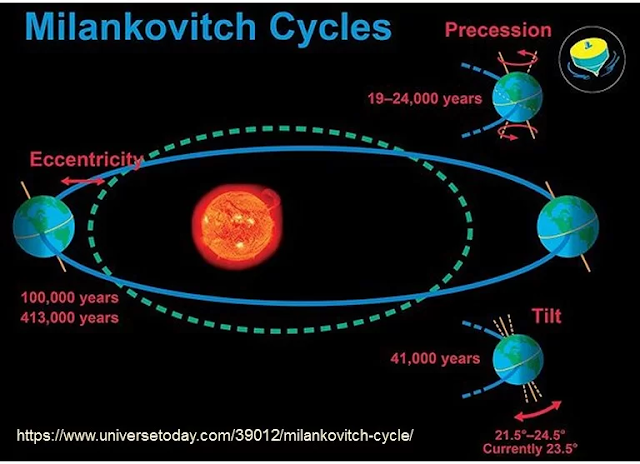Responding to the CO2 Coalition's "Fact #18" on Milankovich Cycles
CO2 Coalition's "Fact #18" is also mostly trivial save for an implication they make from it that is really just a non sequitur. The Milankovich Cycles (sometimes stated simply as orbital cycles) have to do with cyclical variability in the shape of the Earth's orbit or the tilt and wobble of the Earth's axis. They are:
- Eccentricity - cyclical variability in the shape of the Earth's orbit. Due to the gravitational pull of Jupiter and Saturn, the shape of the Earth's orbit becomes more circular (eccentricity of 0.0034) to more elliptical (eccentricity of 0.058) every 100,000 years.
- Obliquity - cyclical variability in the tilt of the Earth's axis, which varies between 22.1 and 24.5 degrees with respect to the Earth's orbital plane every 41,000 years. The more tilted the Earth's axis of rotation, the more extreme seasonal variability becomes. Each hemisphere experiences hotter summers and colder winters.
- Precession - cyclical variability in the wobbles of the Earth's rotational axis every 26,000 years. Think of a spinning top where the axis wobbles a bit as it spins. This cycle makes the seasons more extreme in one hemisphere over the other. When the NH has more seasonal extremes the SH has more moderate variability, and vice versa.
The forcings associated with all three of these are small. In fact, both obliquity and precession average 0 W/m^2 as an annual average. What changes with these is not the total energy received by the earth, but the geographic distribution of energy at various latitudes. Only eccentricity has a forcing that average something other than 0 W/m^2 as an annual average.
The problem that CO2 Coalition runs into is this. They write, "These long-term astronomical changes indicate that changes in CO2 concentration cannot have been the chief reason for warming and cooling in geological time." This is wrong. Orbital forcings are small, and while the glacial cycles of the Quaternary are synced with eccentricity since the Mid-Pleistocene Transition (MPT), the warming associated with the glacial cycles greatly exceeds the forcings associated with these orbital cycles. The lion's share of the work to warm and cool the planet comes from feedbacks, especially from CO2, ice-albedo and dust.
Above is a plot of reconstructed GMST anomalies for the last 800,000 years[1] and the forcings associated with the warming cycles. The largest forcing is greenhouse gas forcings (red), followed by dust (light blue) and ice-albedo (black). Orbital forcings are extremely small compared to each of these. They simply are not strong enough to explain the glacial cycles. The supplementary material shows a more detailed breakdown of the forcings associated with orbital cycles compared to greenhouse gases and dust.
References:
[1] Friedrich et al, "Nonlinear climate sensitivity and its implications for future greenhouse warming," Sci. Adv. 2.11 (2016): e1501923.https://www.researchgate.net/publication/309791338_Nonlinear_climate_sensitivity_and_its_implications_for_future_greenhouse_warming






Comments
Post a Comment